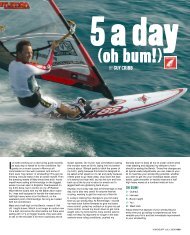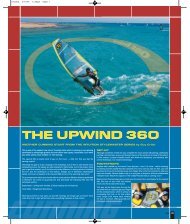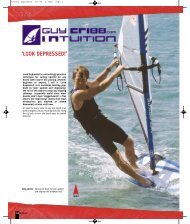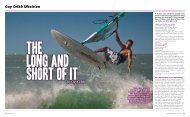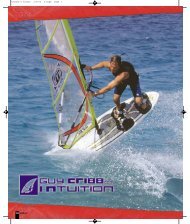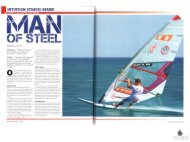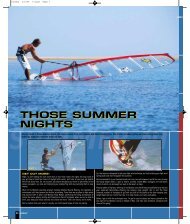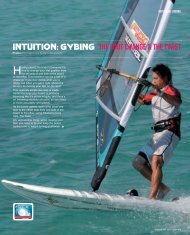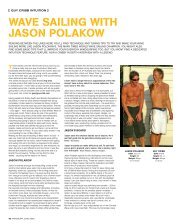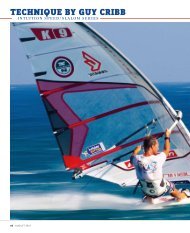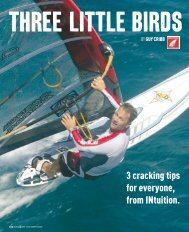You also want an ePaper? Increase the reach of your titles
YUMPU automatically turns print PDFs into web optimized ePapers that Google loves.
<strong>Cribb</strong>y 4/16/04 4:18pm Page 1<br />
DUCKING STUNTS<br />
ING STUNTS<br />
If you’re already comfortable blasting in the footstraps and gybing, then the duck gybe is one of the first<br />
relatively easy freestyle stunts for you, and a useful skill to have under your belt for a freestyle future.<br />
By following this article, duck gybing will become easy, so easy in fact many of my higher level guests<br />
learn it within their first few attempts!<br />
If you’re still learning to gybe, this article also has some fantastic practise points taken directly from my<br />
INtuition Dudes and Legends courses, which will greatly improve your rig flipping. (See onshore<br />
sequence overleaf.)<br />
Broad Reach<br />
Reach<br />
THE DUCK GYBE<br />
There are two main aspects of a duck gybe, the TIMING (on these pages) and the FLIPPING (overleaf).<br />
LEFT:<br />
• Bear off onto a mega broad reach.<br />
• Complete the rig flip.<br />
• Then turn the board and do the foot change.<br />
TIMING IS EVERYTHING!<br />
If you already know the basic routine of how to flip the rig (see overleaf) then making a duck gybe will<br />
all come down to your timing and approach.<br />
78 windsurf<br />
DUCKING
<strong>Cribb</strong>y 4/16/04 4:18pm Page 2<br />
MORE DUCKING<br />
STUNTS<br />
This is a variation to the duck gybe, which if you<br />
already have some duck gybing skills you should<br />
be trying. Sail onto a broad reach, still in the<br />
footstraps, keep the board flat, make the rig go<br />
light, flip it, then carry on sailing clew first! You<br />
have to be pretty physical with this, but it’s easier<br />
than you think!<br />
APPROACH<br />
The faster you are going, the lighter the rig feels, so the easier it is to flip. So despite your gut instinct,<br />
don’t slow down, as that just creates more pull in the rig ensuring an early wipe out.<br />
To keep control on this speedy approach, whether duck gybing or carve gybing, you must increase<br />
the weight on the mast foot to stop the board from ‘wheeling.’<br />
(INtuition Core Skill- www.guycribb.com/technique/coreskills/downforce)<br />
Achieve this by getting all your weight into the harness by sinking down super low, bending your<br />
knees and arms so much your eye level is beneath the boom.<br />
With all your weight in the harness, you should be able to move your back hand freely, sliding it as far<br />
back down the boom as possible. This will increase your leverage on the boom, furthering your control.<br />
From this crouched position, you’re well prepared to handle the surge of power and speed as you<br />
bear off downwind for the gybe.<br />
TIMING<br />
Bear off downwind, pulling hard on your back hand as you go until you’re sailing at about 45 – 60<br />
degrees downwind of a normal reach, ideally within about ten to thirty metres.<br />
When you reach this angle sailing downwind unhook* and move your back foot from the back strap,<br />
placing it on the leeward rail, as per a normal gybe. (*More experienced gybers might unhook and<br />
move their back foot sooner.)<br />
Sometime about now, the rig should go light (because your apparent wind (head wind) is stronger<br />
than the true wind, hence they cancel each other out and you have no wind, making the rig feel light.)<br />
This will only happen if you are truly sheeted right in so the boom is parallel to your board. (100% of<br />
my guests who see themselves on video not sheeting in, thought they were sheeting in on the water.)<br />
When the rig is light it’s easy to flip it.<br />
TIMING - SUMMARY<br />
The best duck gibing tip is not thinking about gybing at all, but to concentrate on flipping the rig whilst<br />
you’re still on a broad reach. Only once it’s completely flipped should you try to carve the board<br />
around the rest of the turn.<br />
TROUBLE SHOOTING<br />
- If the rig isn’t going light as you bear off, then you’re probably sheeting out, which strangely keeps<br />
the power on during this stage. This is the most common mistake of anyone learning to gybe, and the<br />
best solutions are: more downhaul, probably more outhaul, move your harness lines back to where<br />
they should be (www.guycribb.com/technique/tuning/harnesslines) and try this routine again, remembering<br />
to get lower than you’ve ever got before!<br />
SAILING CLEW FIRST<br />
TIPS<br />
- Pull very hard on your clew hand, so that the<br />
clew is pointing directly into the wind, and sheet<br />
out with your mast hand to ditch the power.<br />
- Bring the mast upright.<br />
- If you find that it’s not possible to grab the new side of the boom, because it’s being blown away<br />
from you, it’s because you flipped the rig too late (the most common duck gibing mistake.)<br />
- If the mast is hitting the water and sending you catapulting over the nose of the board, it’s because<br />
there was still too much power in the sail when you let go with your front hand and the rig was blown<br />
straight down in a flash. Sail faster and the rig will be lighter and easier to flip.<br />
There is a chance that the mast hit the water because you weren’t pulling the rig back upright soon<br />
enough- see final page of this feature for tips.<br />
There is no chance that the mast hit the water because your boom is too long, that’s just not a worthy<br />
excuse- you can duck gybe almost any size sail. However if your mast is very heavy, or unfortunately<br />
if you are very short, flipping the rig does become harder.<br />
Finish this trick either by carving the board into a<br />
gybe, as I do here, or flipping the rig as I do in<br />
the onshore sequence overleaf.<br />
- If you’re grabbing the boom on the new side, but being catapulted instantly then either your hands<br />
aren’t reaching far enough forwards, or, if they are reaching far enough, then you’re probably not<br />
pulling the mast back upright soon enough. (See final page of this feature.)<br />
Also, if you’re still on a broad reach, you’ll need to quickly turn the board round to it’s new course, so<br />
bank it over by pushing through your toes.<br />
April 79
<strong>Cribb</strong>y 4/16/04 4:19pm Page 3<br />
KEY POINTS:<br />
Flip rig early.<br />
Get mast back upright asap.<br />
Flip rig early<br />
Keep board banked over to keep it turning (note- when learn-<br />
FLIPPING HECK!<br />
This is the very best way to learn the rig flip routine for a duck gybe and a carve gybe.<br />
If you think you’ll be fine just learning it on the water without any onshore practise,<br />
you’re fooling yourself. There’s a heap of vital actions here that are easily learned on the<br />
beach, but virtually impossible to learn when you’re doing 30mph with spray in your<br />
face mid gybe.<br />
This way of learning is part of my highly evolved INtuition Muscle Memory which has<br />
enabled hundreds of people to understand and master both carve and duck gibing after<br />
about an hour of onshore practise, rather than years of trial and error on the water.<br />
Rig a small sail (4m to 5m), in virtually zero wind in your garden, position your board on<br />
a broad reach and point your front foot forwards. If the neighbours ask you what you’re<br />
doing, tell them “They’re ducking stunts.”<br />
Get mast back upright asap<br />
From a normal sailing position, firstly you’ll learn the duck gybe rig flip (first five images<br />
in sequence.) Then you’ll find your self in the clew first position, which simulates the exit<br />
from a normal gybe, so now you can practise the carve gybe rig flip (last five images in<br />
sequence).<br />
By flipping the rig time and time again, following your INtuition INfo in these pics, you’ll<br />
develop your INtuition Muscle Memory. The more practise you do on land, the easier it<br />
will be for these actions to happen INtuitively on the water.<br />
During my INtuition courses much more is divulged than I have room for here, but try to<br />
copy these actions as best you can, and enjoy these ducking stunts.<br />
Normal sailing position.<br />
Slide back hand right back.<br />
Grab the very back of the<br />
boom arm with your old front<br />
hand (crossing over the top of<br />
your back hand.)<br />
Pull exceptionally hard on<br />
this hand to prevent the mast<br />
from falling down, lifting the<br />
rig back upright (see last<br />
page of feature).<br />
Grab the boom as far<br />
forwards as possible on the<br />
new side with both hands,<br />
moving them quickly<br />
forwards until your front<br />
hand is in it’s normal sailing<br />
position by pulling the mast<br />
more upright. Try to keep all<br />
the power of the rig in your<br />
clew hand, see ‘Clew First<br />
Sailing Tips’ on previous<br />
page.<br />
FLIPPING HECK<br />
80 windsurf<br />
Return to normal sailing position and repeat
<strong>Cribb</strong>y 4/16/04 4:19pm Page 4<br />
ducking<br />
FOOTWORK<br />
Keep board banked over to keep it turning<br />
(Note: when learning you shouldn’t turn as tightly as I do in this sequence)<br />
As you can see the foot change is done well after the rig flip and only after the board has turned all the way round to it’s new course, just like a ‘strap-tostrap’<br />
gybe. If you’ve been following the INtuition series you’ll know the correct footwork is critical to successful gybing and is the second biggest error<br />
would-be gybers make.<br />
Left: Twist your front foot out of the strap and<br />
onto the inside rail, before stepping forwards with<br />
your back foot. Only by doing the Twist can you<br />
keep the board banked over and turning throughout<br />
the gybe.<br />
The correct footwork, which I’ve called ‘The<br />
Twist,’ was first seen in my INtuition feature in<br />
Windsurf July 2002. It’s critical for gybing, tacking<br />
and in much of freestyle, so get it under your belt!<br />
www.guycribb.com/technique/coreskills/thetwist<br />
Begin to rotate the rig. If<br />
there is any wind in your<br />
sail it will want to flip, just<br />
like in a carve gybe.<br />
Boomshaka! www.<br />
guycribb.com/technique/<br />
coreskills/boomshaka<br />
(Slide your mast hand<br />
right to the very front of<br />
the boom, bringing the<br />
mast vertical.)<br />
Your old back hand reaches<br />
around to the new side<br />
of the boom, as far back<br />
as possible. Note how I’m<br />
reaching underneath my<br />
‘Boomshaka’ hand to stay<br />
low with bent legs, instead<br />
of reaching over the top<br />
which would make me<br />
stand upright and blow<br />
the gybe.<br />
Grab the boom just<br />
behind the back harness<br />
line, not too far back.<br />
Missing Link to exit and<br />
back to square one.<br />
(www.guycribb.com/<br />
technique/coreskills/<br />
missinglink) Repeat over<br />
and over until these<br />
movements become<br />
INtuitive and you can do<br />
the carve gibing routine<br />
without looking at your<br />
hands.<br />
WARNING: Do not<br />
practise the on shore<br />
routine in over ten<br />
knots. It is best<br />
practised firstly in zero<br />
wind.<br />
CK!<br />
Return to normal sailing position and repeat<br />
April 81
getting it<br />
FLIPPING DANGEROUS?<br />
<strong>Cribb</strong>y 4/16/04 4:20pm Page 5<br />
The duck gybe is arguably easier than a conventional gybe, mostly because the handwork<br />
and footwork actions are so separate, you get some time to think. It’s best learned with<br />
about a 5.0m to 6.0m sail.<br />
If the rig hits the water at full speed, everything will stop dead, except you, who’ll go flying<br />
clear ahead of everything with a splash and a laugh and zero risk of injury.<br />
The only thing to really watch out for is stabbing yourself in the head with the bottom batten<br />
during the flip. Avoid it by practising the rig flip ashore.<br />
GETTING IT UP!<br />
Another important aspect of the duck is getting<br />
the mast back upright as soon as possible.<br />
There is no ducking action in a duck gybe, more<br />
of a ‘bobbing’ action of the rig. Dropping the rig<br />
right down on one side of you, then flipping it<br />
back up the other. With the rig’s momentum<br />
falling down, you need serious strength to pull it<br />
back up.<br />
Practise this yanking action ashore until you can<br />
really throw the rig right upright over your shoulder,<br />
catching the boom on the new side all the way up<br />
in front of the harness lines.<br />
Even once you’ve caught the new side of<br />
the boom, continue bringing the mast<br />
upright, or even raking it back, as it will<br />
enable a smoother exit from the gybe.<br />
LOOK WHERE YOU’RE GOING<br />
As with all manoeuvres, look to the exit if you want any chance of getting there.<br />
DUCKING STUNTS SUMMARY<br />
Bear off further and further onto a broad reach until the rig goes light, then flip it,<br />
yanking the mast back upright before turning the board around the corner. Try it at<br />
home first, then go for it on the water before you get any older.<br />
UITION<br />
82 windsurf<br />
GUY CRIBB INTUITION<br />
Clearly, the best coaching.<br />
Tune in next month for more cunning stunts by <strong>Cribb</strong>y, or catch him if you can on his UK<br />
Tour April 17-30 at your local beach with your windsurfing shop.<br />
Or for 24/7 INtuition in the sun, join <strong>Guy</strong> for one of his epic windsurfing holidays only at<br />
the world’s best venues at the right time of year for perfect conditions. These are the<br />
ultimate windsurfing trips with the best coaching available, improving your windsurfing<br />
beyond your wildest dreams!<br />
See advert for calendar, or contact:<br />
INtuition Holidays: 01273 842 144<br />
intutition@guycribb.com<br />
www.guycribb.com<br />
Copyright <strong>Guy</strong> <strong>Cribb</strong> 2004<br />
Pics by JC and Whitey.



